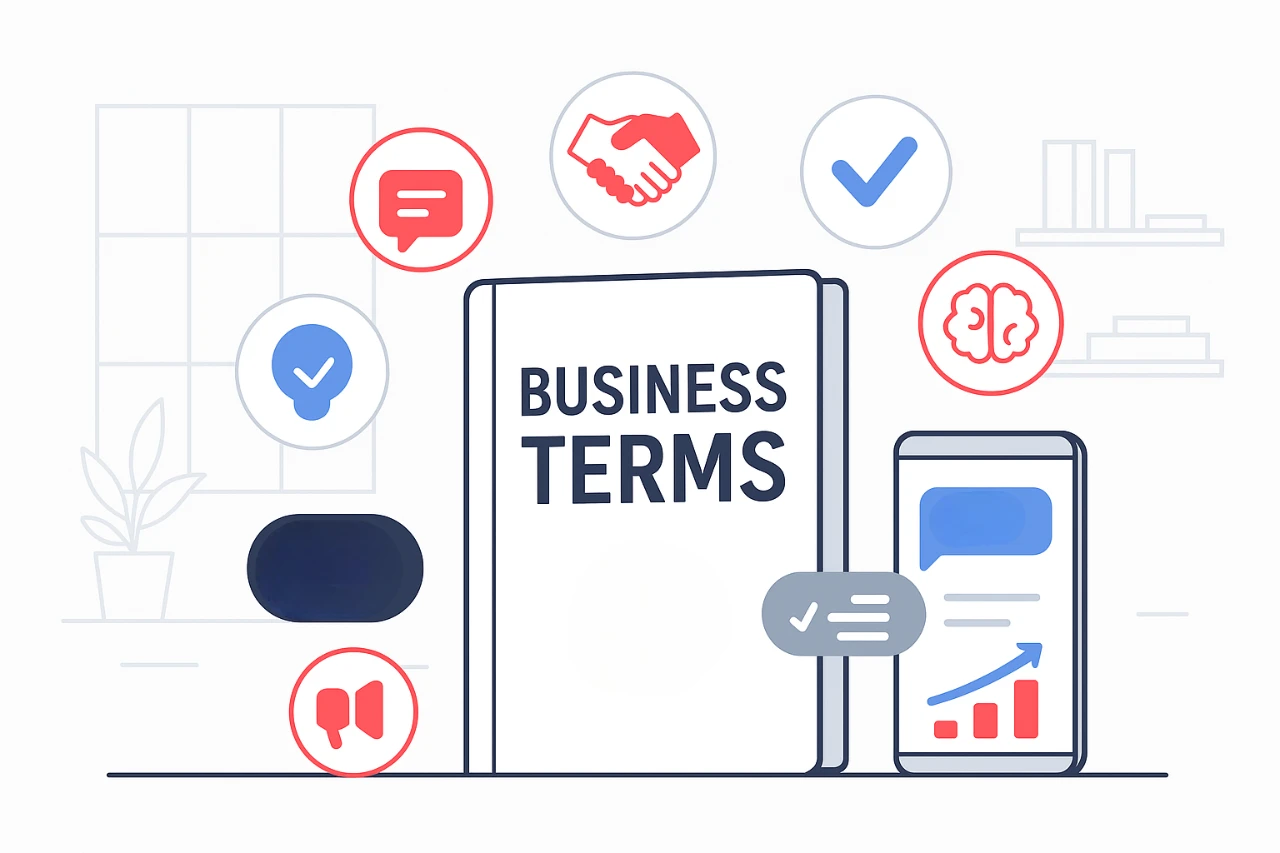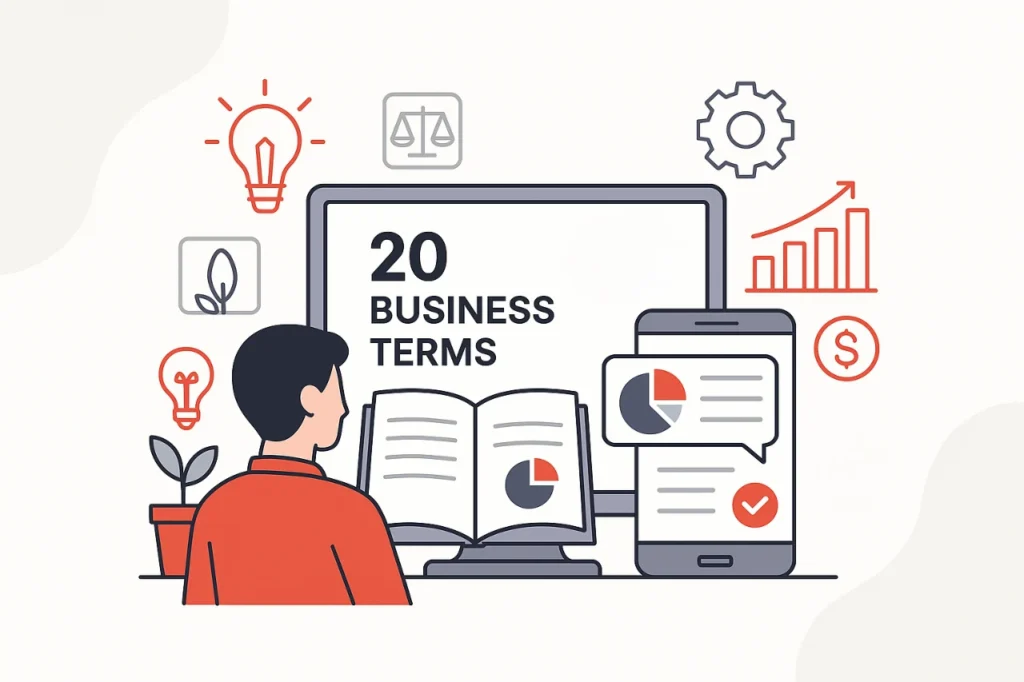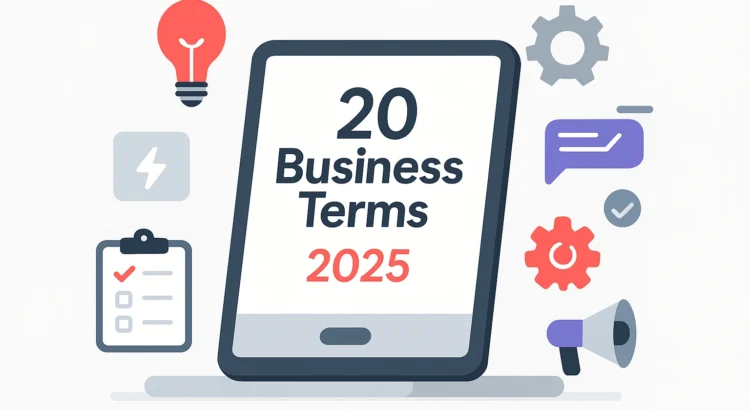Top 20 Business Terms: Your Guide to the World of Entrepreneurship
In today’s business environment, the ability to “speak the same language” with partners, investors, and your team is not just a bonus — it’s a must-have for running a successful business. However, business terminology is constantly evolving, with new terms, English borrowings, and abbreviations appearing every year — and they’re becoming essential for effective communication. Whether you’re just starting your entrepreneurial journey or aiming to scale your business, understanding the core terms of the trade is your first must-have tool.
This article is more than just a business glossary. It’s a hands-on guide that will help you understand key concepts, uncover their logic, avoid common misuses, and show how to adapt business lingo to your specific operations. At the end, you’ll receive a complete list of business terms tailored for 2025 — clear, practical, and jargon-free. And if you’re also looking for tools, not just terminology, take note of sales CRMs that integrate seamlessly with virtually any eCommerce platform.
What Is Business Terminology and Why Does an Entrepreneur Need It?
Business terminology is a set of words, concepts, and abbreviations that form the professional language used by entrepreneurs, investors, executives, and market players. It’s more than just “buzzwords” — it’s a system that allows for clear and concise communication, strategic planning, market analysis, and decision-making. Moreover, these terms serve as the global language of business. If you’re planning to scale, enter international markets, attract foreign clients, or simply run your business more professionally — mastering this vocabulary is non-negotiable. Knowing business terms is not about ticking boxes — it’s a tool as essential as an inventory management system in e-commerce.

Why These 20 Terms? Our Selection Criteria
While a full business dictionary contains thousands of terms, we’ve curated a selection of the most practical ones that:
- Are universal and applicable across various business sectors
- Are commonly used in Ukrainian and international entrepreneurial contexts
- Are featured in MBA programs and business education courses
- Offer real business value, not just buzzword appeal
Business Terminology for 2025: Key Terms
| Term | Definition |
| ROI | Return on Investment |
| B2B | Business to Business |
| B2C | Business to Consumer |
| Cash Flow | Money In/Out of the Business |
| EBITDA | Earnings Before Interest, Taxes, Depreciation, and Amortization |
| USP | Unique Selling Proposition |
| CRM | Customer Relationship Management System |
| Sales Funnel | Customer Journey Model |
| KPI | Key Performance Indicators |
| LTV | Lifetime Value of a Customer |
| CAC | Customer Acquisition Cost |
| MVP | Minimum Viable Product |
| Pivot | Radical Shift in Business Strategy |
| Upsell | Selling a Higher-Priced Version |
| Downsell | Offering a Cheaper Alternative |
| Royalty | Payment for Using Intellectual Property |
| Lead | Potential Customer Contact |
| Conversion Rate | Percentage of Desired Customer Actions |
| Benchmarking | Market Leader Comparison |
| Unit Economics | Profitability per Unit of Product/Service |
Essential Business Terms Every Entrepreneur Should Know

ROI (Return on Investment) – Shows how much profit you earned per every currency unit invested. For instance, if you spent ₴10,000 on ads and earned ₴30,000, your ROI = 200%. It’s a vital metric for assessing business expenses.
B2B (Business to Business) – Your customers are other businesses. Example: You manufacture packaging and sell it to restaurants. This model focuses on long-term cooperation and bulk deals.
B2C (Business to Consumer) – Your clients are end-consumers. Example: You sell clothing through an online store. Personalized marketing and fast service are key.
Cash Flow – One of the most important terms. It represents the difference between incoming (revenue) and outgoing (expenses) money. A business can be profitable on paper but go bankrupt due to lack of liquidity.
EBITDA – A measure of a company’s core profitability before taxes, interest, and depreciation. It’s a common metric for investors to evaluate performance free of external factors.
USP (Unique Selling Proposition) – A clear statement explaining how your product/service stands out. Example: “Sushi delivered in 29 minutes or it’s free.” A good USP grabs attention and gives your business a competitive edge — essential in small business strategy.
CRM – A tool for managing customer interactions. Simply put, it’s a system that helps businesses automate and improve communication with clients — from first contact to repeat sales.
Sales Funnel – A visual model of the customer journey: ad → website → form submission → purchase. Optimizing each step helps increase conversions.
KPI (Key Performance Indicators) – Metrics for measuring performance. For example, a sales manager’s KPI might be “10 deals per month.”
LTV (Lifetime Value) – Total revenue from a customer throughout the relationship. If a customer buys ₴1,000 worth of products monthly for a year, LTV = ₴12,000. This helps decide how much you can spend on acquisition.
CAC (Customer Acquisition Cost) – The cost to attract a single customer. Example: You spend ₴10,000 on marketing and gain 100 customers → CAC = ₴100. Used alongside LTV to assess profitability.
MVP (Minimum Viable Product) – A simplified version of a product with core features to test market demand. For instance, launching a landing page instead of a full app. This saves budget and validates ideas.
Pivot – A strategic change in business direction. If your initial plan fails, you adapt. Example: Instagram started as a check-in app before pivoting into a photo-sharing platform. Sometimes pivoting is key to survival.
Upsell – Selling a higher-tier version of a product. E.g., offering a ₴12,000 smartphone with a better camera instead of a ₴10,000 one. A proven method to increase average transaction size.
Downsell – Offering a cheaper alternative when a client refuses the main product. Helps retain hesitant customers and boost engagement.
Royalty – A recurring payment for using intellectual property (brand, patents, software). Especially relevant in franchising models.
Lead – A potential customer contact who shows interest (e.g., leaves their phone number). Leads are the foundation of sales. With a proper CRM and strategy, they become paying customers.
Conversion Rate – Percentage of users who perform a desired action (e.g., purchase). If 1,000 people view a product and 50 buy it, the conversion rate is 5%. Boosting it is a top priority for marketers.
Benchmarking – Comparing your business performance with market leaders to identify improvement areas. Example: comparing delivery speed to industry benchmarks.
Unit Economics – Profit or loss per individual product/service sold. Example: product costs ₴100 to make and sells for ₴150 → profit per unit = ₴50. Understanding this is essential for building a scalable business.
How to Use Business Terminology in Real Life
Knowing business terms is great — using them correctly is better. Proper use shows your expertise, builds trust, and helps you achieve goals faster.
Partner negotiations: For example: “Our goal is to achieve 30% ROI within three months.” That sounds informed and confident.
Investor pitches: Use terms like CAC, LTV, Unit Economics — they’re signals of maturity and scalability.
Internal team operations: Terms like KPI, OKRs, or Unit Economics streamline planning and decision-making across teams.
Automation setup: Understanding terms like SKU or supply chain optimization prevents costly setup errors when configuring inventory systems.
Mobile applications of the CRM system HugeProfit
Use all the advantages of a mobile device for inventory management:
– mobile barcode scanner
– adding sales in 2 clicks
– creating and tracking TTN
– controlling balances on Prom, Rozetka, OpenCart, Woocommerce, Khoroshop
– Many warehouses and employees
Common Mistakes When Using Business Terms
Using words without understanding: Calling a product backlog “warehouse inventory” makes you look unprofessional. Always double-check terms in trusted glossaries.
Overmixing languages: Instead of saying “low Conversion Rate and bad brand awareness,” just say “low conversion and brand recognition.” Use local terms where possible.
Overusing jargon: Don’t overload sentences with 5 buzzwords. It sounds robotic. Clear and simple always wins.
Ignoring the audience: Avoid throwing around complex terms when talking to small local suppliers. Use full terminology when dealing with investors or tech teams.
Pro tip: keep a personal business term dictionary. Note down definitions and usage examples. It helps build fluency.
Conclusion
Business isn’t just about products, finances, or marketing — it’s about the language you use daily. Mastering business terminology enhances your credibility, improves communication, and positions you as a true professional. Most importantly, business is a game for pros — and language is your tool of influence. Use it skillfully, and new opportunities will open before you.
Join us on Facebook 😉


